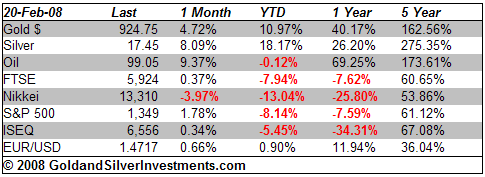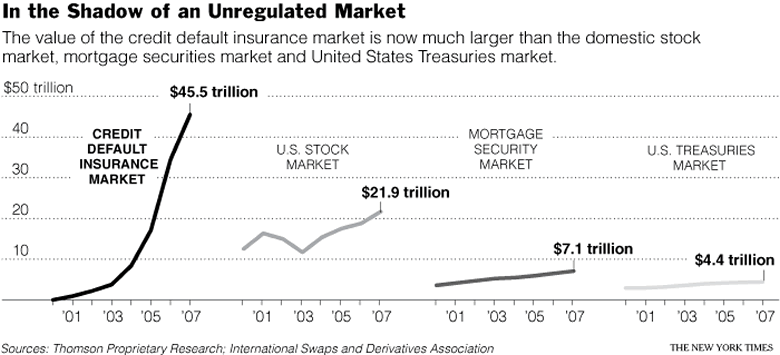Commodities to Outperform Equities on Increasing Macroeconomic and Systemic Risk
Commodities / Gold & Silver Feb 20, 2008 - 09:02 AM GMTBy: Mark_OByrne

 Gold surged $23.55 to $926.80 per ounce in trading in New York yesterday and silver surged 50 cents to $17.50 per ounce. Gold and silver have traded sideways in Asia and early trading in Europe.
Gold surged $23.55 to $926.80 per ounce in trading in New York yesterday and silver surged 50 cents to $17.50 per ounce. Gold and silver have traded sideways in Asia and early trading in Europe.
Gold also surged to new record highs in British pounds and in euro. The London PM Fix at 1500 GMT yesterday afternoon was at $925. Gold fixed at new record highs at £473.68 and €626.91.
After seeing strength in Europe and Asia while the U.S. was out for Presidents Day, gold continued to strengthen on the U.S. markets return and gold surged on increasing inflation concerns with the commodities complex surging, oil rising above $100 a barrel again and the dollar, stocks and bonds falling.
Economics 101 is that weak and declining supply conjoined with strong demand will result in higher prices. Finite natural resources, such as gold and platinum, are being chased by a fastly growing money supply internationally and by fastly growing global population in terms of demographics and wealth.
Analysts have continually expected a correction in the gold price in recent months and this has not materialised. Platinum has now hit new record highs for 14 days in a row and this shows how markets, including commodity markets, can often surprise, both to the downside, and to the upside.

Increasing Macroeconomic and Systemic Risk
Besides the increasingly obvious but barely mentioned spectre of stagflation a la the 1970s there are additional risks in the form of the U.S. housing crash and the deteriorating credit crunch, in addition, the solvency of major banks will likely soon become a real and present danger.
The perceptive Martin Wolf writes in today's FT ('US risks mother of all meltdowns' ). "The link between the bursting housing bubble and the fragile financial system has created huge dangers for the US and the world."
Wolf quotes the sagacious Nuriel Roubini who has been well ahead of the curve in predicting what has transpired in recent weeks. "So how bad might this downturn get? To answer this question we should ask a true bear. My favourite one is Nouriel Roubini of New York University's Stern School of Business, founder of RGE monitor.
Recently, Professor Roubini's scenarios have been dire enough to make the flesh creep. But his thinking deserves to be taken seriously. He first predicted a U.S. recession in July 2006*. At that time, his view was extremely controversial. It is so no longer. Now he states that there is "a rising probability of a 'catastrophic' financial and economic outcome"**. The characteristics of this scenario are, he argues: "A vicious circle where a deep recession makes the financial losses more severe and where, in turn, large and growing financial losses and a financial meltdown make the recession even more severe."
Macroeconomic risk and systemic risk are clearly increasing rather than decreasing as more sanguine analysts would have us believe. The sham alchemy of Wall Street is soon to face another monumental challenge - one that will likely break the camel's back - the unravelling of the ginormous opaque and unregulated Credit Default Swap (CDS) market.

Gretchen Morgenson wrote about them in the NY Times this weekend: Few Americans have heard of credit default swaps, arcane financial instruments invented by Wall Street about a decade ago. But if the economy keeps slowing, credit default swaps, like subprime mortgages, may become a household term. Since 2000, [the market for CDS securities] has ballooned from $900 billion to more than $45.5 trillion — roughly twice the size of the entire United States stock market.
When the trillions of dollars of these derivatives unravels, as seems increasingly likely, we are likely to witness an financial tsunami that will make the subprime crisis look like a small squall in a teacup.
Commodities to Again Outperform Stocks
Investors who ignore commodities and precious metals do so at their peril.
Numerous academic studies have shown that investing in commodities can be less risky than investing in stocks, contrary to the most persistent fantasy of all about commodities. Commodities are not just a good way to diversify a portfolio of stocks, property and bonds; they often offer better returns and importantly they are not correlated to stocks and bonds.
The highly respected 2004 study from the Yale School of Management's Center for International Finance, “Facts and Fantasies About Commodity Futures,” is very important in this regard. Professors Gary Gorton, of the University of Pennsylvania's Wharton School and the National Bureau of Economic Research, and Professor K. Geert Rouwenhorst, of the Yale School of Management, did research that confirms that:
• Since 1959, commodities futures have produced better annual returns than stocks and outperformed bonds even more. Commodities have also had less risk than stocks and bonds, as well as better returns.
• During the 1970s, commodities futures outperformed stocks; during the 1980s the exact opposite was true – evidence of the “negative correlation” between stocks and commodities. Bull markets in commodities are accompanied by bear markets in stocks, and vice versa.
• The returns on commodities futures in the study were “positively correlated” with inflation. Higher commodity prices were the leading wave of high prices in general (i.e., inflation), and that's why commodity returns do better in inflationary times, while stocks and bonds perform poorly.
• The volatility of the returns of commodities futures they examined for a 43-year period was “slightly below” the volatility of the S&P 500 for the same period.
• While investing in commodities companies is one rational way to play a commodity bull market, it is not necessarily the best way. The returns of commodities futures examined in the study were “triple” the returns for stocks in companies that produced those same commodities. Also companies have significantly more risk than owning the actual commodity or tangible asset itself.
Mining shares have accounting and company risk in the form of depending on the performance of employees, management and auditors and considerable risk in the form of political interference and nationalisation, environmental risk, natural disasters, mining accidents and depleting resources.
FX
A busy day on the economic release front today will surely translate into a volatile FX market. This morning's release of the MPC's minutes of the last Bank of England rate setting meeting will give the market a good sense of the degree of worry that the ‘Old Lady' has about the state of the UK economy and the extent of further rate cuts. Sterling has continued to lose ground against the major currencies, falling against the dollar and the yen and briefly consolidating against the euro.
The euro continued to push higher across the board yesterday, helped in no small part by the continuing hawkish tone of the ECB rhetoric and is holding above 1.4700 this morning. The release of the minutes of the FOMC meeting coupled with the CPI data due out today will help determine the short term direction of the dollar.
The commodity currencies and in particular the Australian and New Zealand Dollars have temporarily eased of their highs. The rally in the yen coupled with negative gains in the stock markets and higher precious metals prices all happening in concert suggests that risk aversion is currently in the driving seat across all markets.
Support and Resistance
Gold has consolidated nicely in the $850 to $935 range. Strong support is now seen at $860 and even $900 looks well supported. Any close on a daily basis above $935 should see us challenge $1,000 per ounce in a matter of weeks.
Support is at $886 which was the low on Tuesday February 5th. Next support is at the monthly low on January 21st of $861. Strong support is at $850 to $860. There appears to be strong physical demand internationally for gold in the $890s and thus gold is unlikely to fall far below $890 except for a short period of time.
Silver
Silver is trading at $17.48/50 at 0900GMT.
PGMs
Platinum reached new record highs for the 17th day in a row yesterday and is trading at $2080/2085 (0900GMT).
http://www.goldassets.co.uk /why_invest_in_platinum.php
Palladium surged some 10% yesterday and is trading at $472/478 an ounce (0900GMT).
Technically palladium has broken through resistance at $450. Long term chartists will be looking to palladium's recent record highs in 2001 at $1,100 per ounce as a price target in the medium term.
While these markets are clearly overbought in the short term, markets can remain overbought for long periods and it would be prudent to make the trend your friend.
By Mark O'Byrne, Executive Director
| Gold Investments 63 Fitzwilliam Square Dublin 2 Ireland Ph +353 1 6325010 Fax +353 1 6619664 Email info@gold.ie Web www.gold.ie |
Gold Investments Tower 42, Level 7 25 Old Broad Street London EC2N 1HN United Kingdom Ph +44 (0) 207 0604653 Fax +44 (0) 207 8770708 Email info@www.goldassets.co.uk Web www.goldassets.co.uk |
Gold and Silver Investments Ltd. have been awarded the MoneyMate and Investor Magazine Financial Analyst of 2006.
Mission Statement
Gold and Silver Investments Limited hope to inform our clientele of important financial and economic developments and thus help our clientele and prospective clientele understand our rapidly changing global economy and the implications for their livelihoods and wealth.
We focus on the medium and long term global macroeconomic trends and how they pertain to the precious metal markets and our clienteles savings, investments and livelihoods. We emphasise prudence, safety and security as they are of paramount importance in the preservation of wealth.
Financial Regulation: Gold & Silver Investments Limited trading as Gold Investments is regulated by the Financial Regulator as a multi-agency intermediary. Our Financial Regulator Reference Number is 39656. Gold Investments is registered in the Companies Registration Office under Company number 377252 . Registered for VAT under number 6397252A . Codes of Conduct are imposed by the Financial Regulator and can be accessed at www.financialregulator.ie or from the Financial Regulator at PO Box 9138, College Green, Dublin 2, Ireland. Property, Commodities and Precious Metals are not regulated by the Financial Regulator
Disclaimer: The information in this document has been obtained from sources, which we believe to be reliable. We cannot guarantee its accuracy or completeness. It does not constitute a solicitation for the purchase or sale of any investment. Any person acting on the information contained in this document does so at their own risk. Recommendations in this document may not be suitable for all investors. Individual circumstances should be considered before a decision to invest is taken. Investors should note the following: The value of investments may fall or rise against investors' interests. Income levels from investments may fluctuate. Changes in exchange rates may have an adverse effect on the value of, or income from, investments denominated in foreign currencies. Past experience is not necessarily a guide to future performance.
All the opinions expressed herein are solely those of Gold & Silver Investments Limited and not those of the Perth Mint. They do not reflect the views of the Perth Mint and the Perth Mint accepts no legal liability or responsibility for any claims made or opinions expressed herein.
Mark O'Byrne Archive |
© 2005-2022 http://www.MarketOracle.co.uk - The Market Oracle is a FREE Daily Financial Markets Analysis & Forecasting online publication.


